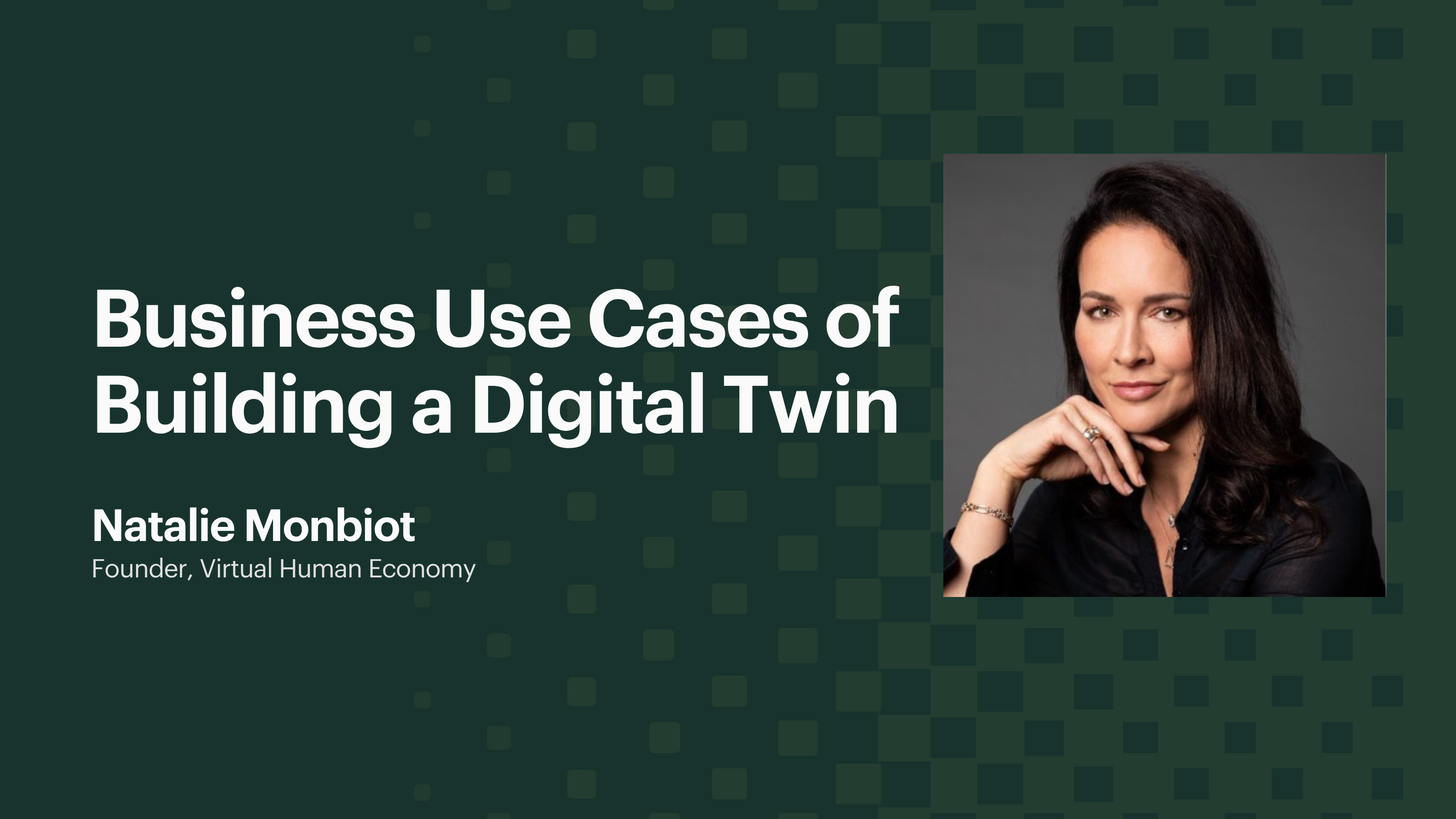In a recent webinar, AI pioneer Natalie shared her journey of building AI twins since 2019 and how the landscape has transformed, offering valuable insights for anyone considering this technology.
The conversation, hosted by Pooja, co-founder of Wizly, revealed how this technology has evolved from being viewed with suspicion to becoming an essential tool for modern businesses. They discussed everything from overcoming initial fears and misconceptions to implementing AI twins that can genuinely transform organizations and help leaders achieve results that would be impossible through traditional methods.
Let's dive into the key lessons and practical strategies that emerged from this fascinating discussion about the future of human-AI collaboration.
Fighting the "Deep Fake" Stigma
"Back then in 2019, this is quite a few years before ChatGPT, people thought it was pretty strange that you could create an avatar, and people were a bit fearful about avatars," Natalie explained. "And the only benchmark or kind of language around this was like deep fake, and which implicitly, you know, communicates something that is not consensual, something that is dangerous, scary."
The term "deep fake" has created a negative association in people's minds. When they heard about AI avatars, they immediately thought of deceptive videos or malicious impersonations. This made it incredibly difficult to convince businesses that AI avatars could be used for legitimate, helpful purposes.
The primary task then was education. Natalie and her team had to convince business leaders of the potential benefits, demonstrating how AI avatars could enable businesses to "create video content at scale and make good on the promise of personalization at scale in video with someone talking like things that were just not possible before."
They were essentially "building a business around trustworthy AI avatars," as Natalie put it, emphasizing that trustworthiness was essential because "if you can't be trustworthy, then why would anybody use you? Why would any company use your avatars, your service in their communications?"
The challenge was convincing people that this technology could be ethical, helpful, and safe.
From "If" to "How"
This shift represents a fundamental change in how people view AI technology. The fear and skepticism have largely been replaced by curiosity and strategic thinking. Business leaders are no longer asking "Is this safe?" or "Will this work?" Instead, they want to know practical details about implementation and results.
The new questions focus on execution: "What are the best practices? How do I go about doing it? And how do we move past the proof of concept stage, the fact that I can create an AI twin, to how can I deploy one in a way that moves the needle?"
This transformation happened remarkably quickly. In just a few years, AI twins went from being viewed as potentially dangerous novelties to being recognized as legitimate business tools. The widespread adoption of AI technologies like ChatGPT helped normalize the concept of conversational AI, making people more comfortable with the idea of AI that can communicate naturally.
Now, instead of having to convince people that AI twins are possible and safe, developers and consultants can focus on helping organizations determine the best ways to implement them for maximum impact.
Thinking Beyond Automation: The 10X Approach
One of the most important insights shared was the distinction between using AI twins for simple automation versus leveraging them for exponential growth. While many studies show AI can increase productivity by modest amounts, the real opportunity lies in achieving dramatic performance improvements.
"I think there's a lot of studies out early on in the last, let's say three years, that are showing like, oh, you can achieve a 15% increase in productivity by using AI. That's not that exciting," Natalie noted. "But there are other ways and other sorts of approaches, which lead to more like 10X output or 10X performance, right?"
The key is thinking bigger than just making existing processes slightly more efficient. Most people initially think about AI twins in terms of automation – having the AI do tasks they currently do manually. While this can save time, it's a limited way to think about the technology.
Rather than just automating existing tasks, successful AI twin implementation focuses on enabling capabilities that were previously impossible. Natalie provided a compelling example: "How many languages do you personally speak? And therefore, what is your total addressable market for the language that you speak? How could you quadruple or 10X the total addressable market of people you can speak to by speaking their languages?"
This example illustrates the transformative potential of AI twins. If you only speak English, you can only directly communicate with English speakers. But an AI twin could allow you to have natural conversations in Spanish, French, Mandarin, or dozens of other languages, instantly expanding your potential market by 4X, 10X, or even more.
The key insight is to think bigger: "We should be thinking much bigger in terms of like how you can use it in AI twin, not to just automate tasks that you do daily, which is also important, but to think about like, what can I achieve that I couldn't before?"
Encoding Wisdom and Personality
A critical distinction emerges between basic chatbots and effective AI twins. While knowledge has become commoditized, anyone can ask ChatGPT for factual information, but what people truly value is wisdom gained from lived experience.
"Knowledge, right, has been completely commoditized," Natalie explained. "It feels like it just like spouts a response. It's just like, stop, stop, fewer words, less knowledge. It's just cheap knowledge, right? Like, no, it's not wrong. But it's just that I don't want that. I don't need that. It's not useful. It's lost its value."
This observation highlights a common frustration with AI tools. While they can provide accurate information, they often deliver generic, lengthy responses that feel impersonal and unhelpful. The information might be correct, but it lacks the nuance and insight that comes from real experience.
What people want instead is "wisdom, and acquired wisdom from lived experience." This is where AI twins can provide unique value by being based "truly on you. And, you know, your conviction, your tone of voice, your actual lived experiences, and the nuances of how you talk."
The difference between information and wisdom is crucial. Information is factual data that anyone can look up. Wisdom is the insight that comes from applying that information in real situations, learning from mistakes, and developing judgment over time. This is what makes a successful executive, teacher, or consultant valuable – not just what they know, but how they think about problems and make decisions.
Creating an effective AI twin requires balancing three key elements:
Factuality: Training on relevant documents, case studies, and knowledge base materials provides the foundation of accurate information. This includes your published work, case studies, research, and other factual content that establishes your expertise.
Personality: Capturing your unique tone of voice, conversational style, and personal quirks makes the AI twin engaging and distinctly you. As Natalie emphasized, "You really have to have it mirror or capture your personality. So balancing factuality with personality is key." This includes how you phrase things, your sense of humor, your pet phrases, and your communication style.
Purpose: Defining clear objectives is crucial. "What is what does your AI twin offer? Like, what is the goal? What are you moving towards? I think is important," Natalie stressed. Without a clear purpose, an AI twin becomes just another generic chatbot.
The goal is creating something that feels authentically you – something that people can immediately recognize as your voice and perspective, even when they know they're talking to an AI.
Real-World Success: A Healthcare CEO Case Study
Natalie shared an exciting example of strategic AI twin implementation with a healthcare CEO managing thousands of employees across multiple companies. This case study illustrates how AI twins can be used strategically rather than just as novelties.
The project began with a crucial decision about purpose: "Are you, you know, you want to create like a fun AI twin, you know, because you can't, you know, because it's like a novelty, or do you want to create a strategic AI twin? And he went with strategy."
This choice between "fun" and "strategic" is important. Many people are initially attracted to AI twins because they seem cool or interesting. But to get real business value, you need to think strategically about what you're trying to achieve.
The goal for this healthcare CEO was ambitious: "How does he with a lot of wisdom, right? He's had a lot of startups, and he's been extraordinarily successful. How does he capture his wisdom, and his personality has also got a really big personality, and make that available to every single employee on a one-to-one basis?"
The challenge was scale. This CEO had built multiple successful companies and had valuable insights to share. He also had a very personal leadership style – "he's the kind of person that knows everybody's birthdays and things like that, like, he makes it his business to know these things." But with thousands of employees, he couldn't have personal conversations with everyone.
The AI twin provided a solution. It allowed him to scale his personal leadership approach across the entire organization. Every employee could have a one-on-one conversation with the CEO's AI twin, getting both practical information and personal guidance.
The twin provides both practical information and personality-driven insights. For example, it might tell new employees factual information about their first 90 days, but also include personality-driven advice like "you better ask all the questions in the first 90 days, because if you ask up, if you're asking next year, people are going to think you're dumb."
The result is that employees get access to their CEO's wisdom and personality at scale, something that would be impossible without AI technology. It's not just about providing information – it's about creating a connection and sharing leadership insights in a personal way.
Building Your AI Twin: Data and Tools
Creating an effective AI twin requires the right data and approach. The quality of your AI twin depends heavily on the quality and variety of data you use to train it. Natalie recommends several strategies for gathering quality training data:
Recorded Conversations: "It helps if you have a lot of data. And if you don't have a lot of data, go about consistently, creating a lot of data, and good ways to do that are in conversations like this and just make sure they're recorded."
This means being intentional about recording your conversations, interviews, presentations, and other speaking engagements. Every conversation where you're sharing your expertise or demonstrating your communication style is potential training data for your AI twin.
Natural Speech Patterns: Off-the-cuff responses are particularly valuable because "responding off the cuff adds a lot of richness and nuance that can then create a more interesting and insightful and human-like AI twin."
Prepared speeches and written content are useful, but spontaneous conversations often reveal more about how you think and communicate. The little pauses, the way you rephrase things, the examples you choose on the spot – these all contribute to making your AI twin feel more authentic.
Multiple Data Sources: Platforms like Zoom calls, podcast interviews, and written content all contribute to building a comprehensive picture of how you communicate. The more diverse your data sources, the more well-rounded your AI twin will be.
Regarding the amount of data needed, Natalie noted that "40,000 words is probably like a good amount of words to have to have like a base conversational AI twin that can represent you." This might sound like a lot, but it's quite achievable when you consider transcripts from presentations, interviews, written articles, and other content you've already created.
However, she emphasized quality over quantity: "You should control and curate the data so that there's accurate stuff and not personal stuff." Not everything you've ever said should go into your AI twin. You need to be selective and include only content that represents how you want your AI twin to communicate.
The process isn't just about dumping all your content into a system. It requires thoughtful curation to ensure your AI twin represents the best version of your professional self.
Technology Behind AI Twins
The technical implementation varies depending on the platform and use case. For enterprise solutions, the process might involve custom development and integration with existing systems like Slack. However, platforms like Wizly have simplified the process significantly for individual users and smaller organizations.
As Pooja explained the user experience: "With Wizly, you sign up as a expert on the, as in, if you want to create your AI twin, you create a profile, you upload data, we integrate with tools like LinkedIn, we've just added Substack in the next couple of days, and Notion, so where your body of work is usually, so that it helps train the data."
This integration approach is smart because it pulls from places where you're already creating content. Instead of having to manually upload everything, the platform can automatically incorporate your LinkedIn posts, articles, presentations, and other existing content.
The platform uses a RAG (Retrieval-Augmented Generation) approach, which is important for accuracy: "The way a RAG works is like a knowledge graph. So if you ask your twin a question, it's only going to pick from whatever documents and whatever data you've trained it with versus any external sources."
This approach prevents a common problem with AI systems called "hallucination" – when the AI makes up information that isn't based on real data. By limiting the AI twin to only your approved content, it ensures that responses are based on things you've said or written.
The system also includes continuous updates, which are crucial for keeping your AI twin current: "Every so often, I'll get will prompt, Oh, do you want to add these LinkedIn posts to your training data for your twin? And so then I can approve that. And my twin gets updated, and I'm not like, oh, my twin, you know, like a deck gets outdated."
This ongoing update process means your AI twin evolves with you. As you create new content or develop new insights, your AI twin can incorporate these changes, staying current with your latest thinking.
AI Twins in Education: Personalized Learning
The potential for AI twins extends beyond business applications into education, where they can address one of the most persistent challenges in learning: the fact that every student is different.
"One key gap in education in general is the fact that, you know, different children or different, you know, kids in the classroom have different needs, right? They're different, they have different learning needs, different learning styles, and it's not a one-size-fits-all," Natalie observed.
Traditional education often struggles with this reality. Teachers have to design lessons for an entire class, but students learn at different paces and in different ways. Some students might be ready for advanced concepts while others are still mastering the basics. Some learn better through visual examples while others prefer hands-on activities.
AI twins offer a potential solution through personalized learning. Natalie shared an example from Alpha School, where "most of the curriculum, especially focused on STEM, is done within two hours and with a personalized AI tutor in the classroom."
This approach allows each student to work with an AI tutor that adapts to their individual needs and pace: "You could have someone who's got doing grade two math and someone doing grade four math, like, you know, sitting next to each other, but at the end of the day, they will all get to the same place."
The efficiency gains from AI tutoring create opportunities for other important aspects of education: "The rest of the school day is dedicated to social skills, like basically, it's like using AI to get the stuff that needs to get done out of the way in the most effective and personalized way."
This model recognizes that while AI can be excellent at delivering personalized instruction, human skills remain crucial. By using AI to handle the knowledge transfer efficiently, teachers can focus on developing students' social skills, creativity, critical thinking, and other uniquely human capabilities.
Natalie emphasized the importance of this balance: "In this era of AI, where who you are, right, like, if you don't have conviction, if you don't haven't focused on your human ingenuity, you are less valuable in this world."
The goal isn't to replace human teachers but to use AI to make education more efficient and personalized, freeing up time for the human elements that are becoming increasingly important in an AI-powered world.



.jpg)